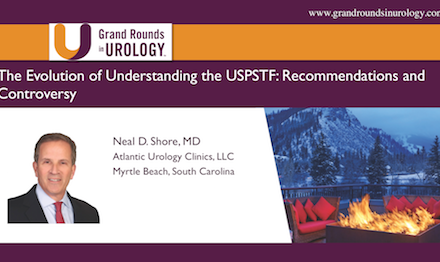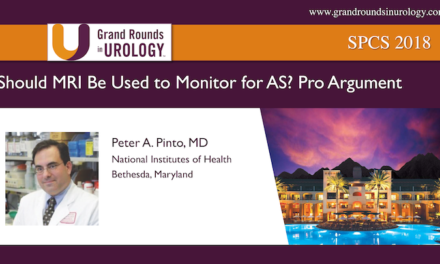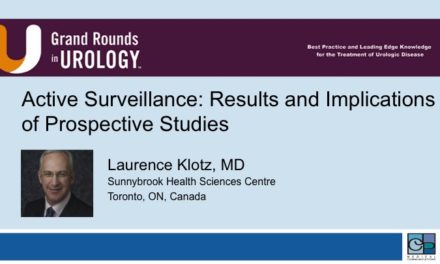Dr. E. David Crawford presented “The “Who’s” of Genomic Markers: Who to Biopsy” at the 27th annual International Prostate Cancer Update meeting on Wednesday, January 25, 2017.
Keywords: prostate cancer, genomic markers, biopsy, Gleason score, PSA, PCA, PCM, focal therapy
How to cite: Crawford, E. David. “The “Who’s” of Genomic Markers: Who to Biopsy”. January 25, 2017. Accessed Nov 2024. https://dev.grandroundsinurology.com/whos-genetic-markers-biopsy
Transcript
The “Who’s” of Genomic Markers: Who to Biopsy
So, my topic is talk about in genomic markers whom to biopsy. And I think this is probably one of the more critical areas here. This is where it all starts. This is where a lot of the controversy exists about too many biopsies and finding “benign” cancers and the complication of biopsies. So these are my disclosures. As many of you know, this whole thing about genomic markers is taking over the national press. It’s becoming a very timely topic at meetings, and rightfully so. I think it falls within what I consider the three biggest advancements in urology in the last decade. And the one I’m going to talk about, PCMs, or prostate cancer markers. The second one is next generation sequencing, which have opened up a lot of doors for us understanding genetics and genomics in prostate cancer. And finally, the arena of all these new drugs that are out there for advanced prostate cancer. They’re all different, and they’re all making major contributions in patient outcome and survival.
So I think that the needs out there starting in prostate cancer are many. But one is we need to start with family practice doctors, and we know why, because they’re the ones that see the patients first and order the most PSAs. Early detection, I think we have to redirect, refocus, and change this to this early detection of clinically significant cancers. We’ve got to stop doing biopsy, after biopsy, after biopsy on men and focus on biopsying men, again, who have a significant risk of cancer, or who have a significant risk of a cancer that was missed on our initial biopsies. We need to enhance risk stratification, having patients assigned to active surveillance or interventional therapy. And I think one of the newer exciting areas that we need to deal with is germline mutations in prostate cancer.
So what are PCMs? PCMs are something that is a molecule that can be found in blood, tissue, or body fluids that’s a sign of normal or abnormal process. And obviously, blood and urine are easy to access, tissue is a little bit more difficult. But some of these prostate cancer markers need tissue, at least at this point. So we like to compartmentalize this, and Neal Shore and I worked on this, and this has evolved. We started out with three buckets; whom to biopsy, whom to rebiopsy and who to treat. Now we’re up to five. The first bucket is identifying who should have an initial biopsy. And we’re going to talk about three of those tests, SelectMDx, Phi, and 4K score. And then negative biopsies; whom to rebiopsy. And there are a number of different ones of this bucket, primarily confirmMDx. Then whom to offer genetic testing, and those are certainly men who have metastatic prostate cancer, and men who have other risk factors; earlier disease, multiple family members, breast cancers, melanomas, all these things that go with the need for germline testing. And then who to offer active surveillance to. And we have some great tests here to help us to navigate this path. And then in men who have had a treatment, radical prostatectomy, that’s the last bucket, who to treat or not to treat with radiation, hormone therapy, and other things like that.
So with markers, they’re not all black and white. And I sort of like to think of them as relative risk. So here’s the bank and here’s the man. What’s his risk of being bank robber? Well, if he comes in with sunglasses, not a lot. It is a factor. If he comes in with a backpack, that raises it a little bit. If he comes in with a walkie-talkie that raises it a little bit. And if he’s carrying a gun that’s a big factor. And so that’s a big gene so to speak. But in all of these things, these genes that we’re looking at, these risk factors are important, but none of these things are 100%. He may actually be a police officer and that was the reason he was dressed the way he was. So we all know and have heard about the fallout from the US Services Preventative Task Force, giving this a D. And there’s a lot of discussion right now about what that means, what’s going to change and things like that. Many of us believe that a correction was needed. Not the correction that we had, but the pendulum needs to come back from swinging back and forth so far away.
There’s a saying that is what is good for the goose is good for the gander, and this is just less than a year old, the periodic physical exam of the President of the United States, Barrack Obama. And buried on the second page was the fact that he had a PSA, and it was 0.84 nanograms per milliliter. Was there informed decision here? We get US Service Preventive Task Force said there should have been. I don’t think there was, but I wasn’t there so I don’t know. But I do know that there are a lot of challenges that exist with early detection. PSA screening, as you well know, has poor specificity, too many negative biopsies, over-detection, overtreatment, false negative biopsies, risk stratification issues, and all of these things, which are the downside. The upside is we do think that there are men that benefit from finding the right prostate cancer.
So using PSA alone to guide prostate biopsy decisions for the most part should end. That is the first level, but it shouldn’t be the decision all the time to do a biopsy. Of course, unless somebody comes in, their PSA is 35 and they’ve got a nodule and things like that, but we’re talking about the average guy off the street we see with sort of a borderline PSA, normal rectal exam. We need tools to better use precision medicine to reduce unnecessary biopsies and reduce over detection of indolent cancers.
So precision medicine is a term that’s thrown a lot, around a lot. We’ve been using it in prostate cancer since the 40s with acid phosphatase, with specific treatments and things like that, estrogens and so forth, but it’s getting better. We’re being aided by genomic and proteomics, and other things that help us to drill down on the persons who would benefit from a specific action.
So for your iPads here and for the Array Technology we need you to vote on this. What percent of all PSAs in the US are ordered by urologists, 27%, 13%, 2%, 6%, or 19%? Got it?
So, the group thinks that—54% got it right, it’s 6%. All right, let’s go to the next slide. And in fact, this was a shocking data when I saw it first, because I thought urologists were a major contributor to PSAs. Actually, over 90% are ordered by family practice and internal medicine doctors. So where do you start? You start with them, obviously.
All right, here’s a problem, and we’ve confused family practice doctors. We have the US Service Preventive Task Force. And one of the reasons I think they’ve been so accepting is the fact that PSA screening has been sort of a quagmire for them. We tell them the PSA cutoff is 1.5, we say it’s 2.5, we talk about PSA velocity, density, age-specific PSA, percent-free PSA, complex PSA, Phi, PCA3, SelectMDx, 4K, it goes on, and they go help. They need a simple message, and that’s what the next part of it. And not something we did a number of years ago looking at the Henry Ford database. We wanted to find out, is there a PSA cutoff below which there’s relatively low risk that you can say to the family practice doctor, remember this one thing, above that it’s a danger zone. And in fact, what we showed, and this was actually something that we knew, I knew already from the PLCO data that we were involved in that, that trial, is that a PSA of less than 1.5, at least for 5 years, your relative risk of being diagnosed with prostate cancer is very low. It’s like 0.5%; whereas, if you’re in this group right here, above 1.5 to 4.0, not above 4.0, 1.5 to 4.0 you’re relative risk goes up. That’s a danger zone. That’s a zone where we might have an opportunity to find prostate cancer earlier and find some significant disease is what we want to do. If you look at PSA of 1.5 and above, up to 4.0, most of the time the cause is BPH, not prostate cancer. So everybody, and where we got into trouble, we start biopsying these people, and we know that the autopsy incidence of prostate cancer in 50-year-old men is 25% to 30% or so, we were finding those. And that was a problem. So we have a PSA of 1.5 as an indicator for BPH, it’s also an indicator for progression. It’s precision medicine, focusing on those people. It’s associated with prostatic symptomology.
This is our publication, which came out a couple of months ago in October in Urology, and it dealt with that level of 1.5. And I must say, I’m very proud of all the people that contributed to this that are on this author list. And Alan Partin was one of the first to rank this and give it one of the top stories in Urology in prostate cancer for 2016, and using this approach of 1.5.
What percent of men have an initial PSA of greater than 1.5? That’s a question. And go ahead and guess, is it 18%, 27%, 14%, 22%?
So the issue is, is that are we going to be putting a lot of guys at risk of needing to be evaluated that we can’t handle? Okay, the answer, so most people got that correct. So let’s go and look at that. So we actually looked at that with data from BioReference Lab, and Matt Rosenberg did this. And what we found out was that in fact 73% of men had a PSA of less than 1.5. So that means 27% fall into that gray zone.
If we look at early detection ways forward I think we should treat PSA like everything else that the family practice does. They get informed decision when the test is abnormal. They don’t get informed decision, they check your blood pressure, they check your weight. They don’t tell you if I check your blood pressure and I put you on an antihypertensive you may pass out. They don’t tell you that before they check your blood pressure. They tell you afterwards. The same thing with cholesterol. They don’t tell you if I check your cholesterol and put you on a statin you might have rhabdomyolysis and have renal failure. They don’t tell you about all the outcomes. When they draw a blood sugar they don’t start to treat you for diabetes, they do an A1C. And when you have chest pain or you have an abnormal EKG they don’t do a bypass right away, they go to the next level of tests. When you have an abnormal PSA you go to the next level of tests, you just don’t biopsy somebody unless, again, it’s above 4.0 or whatever your threshold is. So it is a surrogate to go forward.
This sort of our diagram here of how we deal with this, PSA greater than 1.5. Urologists, and then this, we’re going to talk about these things right now to help define the next level of testing. Gleason 6, active surveillance, so we want to get rid of it. So this is our initial biopsy of who to do it. PSA is in an area where we think we should do it, SelectMDx, Phi and 4k. Phi is a good test. Detman Colter’s, as I mentioned earlier, Dr. Partin has done a lot of work with that in this whole group, Stacy Loeb, many others. There’s a nice reflection with the risk of prostate cancer, and they and others, including Lee, have done some work showing there is a risk stratification between Gleason 7 and 6s with the Phi score. PCA3 is a good test to detect prostate cancer, unfortunately, it doesn’t help us find prostate cancers that need to be treated. 4K test is another good test. It’s a blood test. It looks at four ingredients, one of the main ones is HK2. And then it couples with age, DRE and prior biopsy status, and gives you a relative risk of having prostate cancer. And you have to look at that and decide what you think is important, and you get a report back like this, it puts you at low risk, intermediate, high risk, and what your 4Kscore is. You discuss that with the patient, what are they willing accept? I mean some patients will accept 15%, 20% depending on things.
All right, the other one that I want to talk about is SelectMDx, which is the sort of second generation PCA3 test. It was developed by Jack Schalken, who also developed PCA3. It’s two genes which are associated with a higher risk of prostate cancer, pattern 3443 and above. And so these tests, it’s a urine test done after a gentle DRE. And what happens is it gives you a very low risk or it gives you a relative risk much like the 4K score. It will tell you what your chances are of having a prostate cancer. What I like in here is when we do this, the very low risk, and what we see and can tell a patient basically is you’ve got a 99% negative predictive value. You don’t have a Gleason 8 cancer and above, and a 98% chance for at least a Gleason 7. So this is the publication that’s out there, 98% negative predictive value, 99% for Gleason 8. If you look, those of you like ROC curves can see here that this ROC curve out performs the prostate cancer calculator and PCA3, and here on the right what we see is that there is a differentiation here with a 98% negative predictive value for higher grade cancers. So this is the report you get back for very low risk. It’s very reassuring to talk to patients about that, how you feel. And then this one on the left here shows a 50% chance that you have a higher grade cancer pattern 3443 and above, and it also gives you relative risk of having cancer. So it also can have a high-risk of having cancer, but a low risk of having higher grade cancer. But the real differentiation here is in the negative predictive value in a lot of patients that I’m seeing.
And so we’re going to be reporting some of this stuff at meetings coming up, association mapping biopsies and the sensitivity and specificity that are even not 99%, but 100%. Obviously, when we get more patients that’s probably going to down to the 99% or whatever, we’ll see. So PCMs are our friend right now. They help us navigate all this stuff. They help us to eliminate Gleason 6 cancers and eliminate active surveillance. This is the table in our publication that goes through these markers that we use as the next level, and I think we should become familiar with these. Thank you.
ABOUT THE AUTHOR
Researcher-physician E. David Crawford, MD, has devoted his career in medicine to educating the public about men's health issues and finding effective techniques and procedures to address prostate cancer, the most common malignancy affecting men in the United States.
He is currently a Professor of Urology at the University of California, San Diego, and emeritus distinguished endowed Professor of Surgery, Urology, and Radiation Oncology, and Head of the Section of Urologic Oncology at the University of Colorado Anschutz Medical Campus in Aurora, Colorado. Dr. Crawford received his medical degree from the University of Cincinnati and his postgraduate training included an internship and residency in urology at the Good Samaritan Hospital in Cincinnati. He subsequently completed a genitourinary cancer fellowship at the University of California Medical Center in Los Angeles.
Dr. Crawford is an internationally recognized expert in benign prostate hypertrophy, urologic cancers, and in particular, prostate cancer. He has conducted research in the treatment of advanced bladder cancer, metastatic adenocarcinoma of the prostate, hormone-refractory prostate cancer, and other areas of urological infections and malignancies. He has authored or coauthored over 810 scientific articles, has published seven textbooks, authored over 60 book chapters, and provided more than 2,200 educational talks for patients and physicians.
In an effort to raise public awareness about prostate health, Crawford in 1989 founded the Prostate Conditions Education Council (PCEC). The non-profit organization is comprised of a consortium of leading physicians, health educators, scientists, and men's health advocates. PCEC's advocacy for free or low-cost prostate screening has affected the lives of millions of American men. He currently chairs the PCEC.
Crawford is an active member of many national and international organizations, including the American Society of Clinical Oncology, the American Urological Association (AUA), and the American Association for the Advancement of Science. Within the AUA, he has been a member of the Committee to Study Urologic Research Funding and the prostate cancer clinical trials subcommittee. Crawford served on the board of governors, the scientific advisory board of the Southwest Oncology Group, and was chairman of the Genitourinary Cancer Committee for 27 years. This group is the largest clinical trials group in the world.
Crawford's involvement in the national prostate cancer arena has been widely recognized. He has received many honors and awards, including the CAP Cure Annual Award for Scientific Presentation in 1999 In 1997, he was presented with a 'Freddie Award" at the AMA International Health and Medical Film Competition for the program, ITV: The Cutting Edge Medical Report (Prostate Cancer: Understanding, Diagnosing, and Defeating), which Crawford hosted with special guest, retired General Norman Schwarzkopf.
Crawford again won a prestigious 'Freddie Award" 5 years ago... He is a member of Best Doctors of America and was named Healthcare Provider of the Year in the Denver Metro area by the Denver Business Journal.
He has been recognized as one of the Best Doctors of America for the past two decades and is recognized as one of the top 20 urologists in the country, for men, by Men’s Health Magazine. In 2018 he received the honor of being named the Distinguished Alumnus of the Year from the University of Cincinnati School of Medicine. In May of 2019, he received the Presidential citation from the American Urological Association recognizing for his “tireless role in genitourinary cancer research that has benefited countless urologic cancer patients.” He accepted the position of Editor in Chief of Grand Rounds in Urology in June of 2019. In 2021, he was the recipient of the Merle Stringer, M.D. annual award for excellence in medicine by the Florida State Medical Association.





